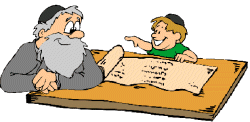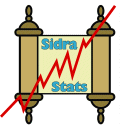Tetzaveh
תְּצַוֶּה
Exodus 27:20 – 30:10
Oil for the Lamp
You, Moses, must command the Israelites to bring you clear illuminating oil, made from hand crushed olives, to keep the lamp constantly burning.
Aaron and his sons shall arrange for the lamps to burn from evening until morning in HaShem’s presence, in the Communion Tent, outside the cloth partition that conceals the Ark of Testimony. It is a rule for all time that this oil shall come from the Israelites.
The Priestly Vestments
Separate your brother Aaron and his sons from among the Israelites, and bring them close to you so that Aaron, and his sons, Nadav, Avihu, Eleazar and Ithamar, can become priests to Me.
Make sacred vestments that are both dignified and beautiful for your brother Aaron. Speak to everyone who is naturally talented, to whom I have granted a spirit of wisdom, and let them make Aaron’s vestments. These vestments will then be used to consecrate him and make him a priest to Me.
These are the vestments that they shall make: a breastplate, an ephod, a robe, a knitted tunic, a turban, and a sash. Make them as sacred vestments for Aaron and his sons so that they will be able to be priests to Me.
The skilled workers shall take the gold, the sky-blue, dark red and crimsons wool, and the linen.
The Ephod
These workers shall make the ephod out of gold thread, sky-blue, dark red and crimson wool, together with twined linen, in a patterned brocade. It shall have two attached shoulder pieces at its two corners, and these shall be sewn to it. The ephod’s belt which is made in the same manner as the ephod itself shall be woven together with it out of gold thread, sky-blue, dark red, and crimson wool, and twined linen.
Take two sardonyx stones, and engrave on them the names of Israel’s sons. There shall be six names on one stone, and the remaining six names on the second stone inscribed in the order of their birth.
The names of Israel’s sons shall be engraved by a skilled jeweler, and it shall appear like the engraving on a signet ring. These stones shall then be placed in gold settings.
Place the two stones on the two shoulder pieces of the ephod as remembrance stones for Israel’s sons.
The Settings
Make gold settings. Also make matched cables of pure gold, braided like cords. The braided cables shall then be attached to the settings.
The Breastplate
Make a decision breastplate. It shall be a patterned brocade like the ephod. Make it out of gold thread, sky-blue, dark red and crimson wool, and twined linen. When folded over, it shall be a span long and a span wide.
Set it with four rows of mounted stones. The first of these rows shall contain a carnelian, an emerald and a topaz. The second row: carbuncle, sapphire, beryl. The third row: jacinth, agate, amethyst. The fourth row: chrysolite, onyx, jasper. These stones shall be placed in gold settings. The stones shall contain the names of the twelve sons of Israel, one for each of the twelve stones.
Each one’s name shall be engraved as on a signet ring, to represent the twelve tribes. Make matched cables out of pure gold, braided like cords, for the breastplate.
Make two gold rings for the breastplate, and attach them to the two upper corners of the breastplate. Attach the two gold braids to the two rings on the two corners of the breastplate. Attach the two braids on the two corners to the two settings, and they shall thus be attached to the two shoulder pieces of the ephod, toward the front. Make two gold rings, and attach them to the two lower corners of the breastplate, on the edge that is toward the inside of the ephod.
Make another two gold rings, and attach them to the bottoms of the two shoulder pieces, toward the front where they are sewn on, above the ephod’s belt. Lace the lower rings of the breastplate to the lower rings of the ephod with a twist of sky-blue wool, so that the breastplate shall remain directly above the ephod’s belt.
Aaron will thus carry the names of Israel’s sons on the decision breastplate over his heart when he comes into the sanctuary. It shall be a constant remembrance before HaShem.
Place the Urim and Thumim in the decision breastplate, and they shall be over Aaron’s heart when he comes before HaShem. Aaron will then carry the decision-making device for the Israelites before HaShem at all times.
The Robe
Make the robe that is worn under the ephod completely out of sky-blue wool. It shall have an opening for the head in the middle, and this opening shall have a woven border all around it, like there is around the head opening of a coat of mail. The neck shall thus not be left open.
On the bottom of the robe, place pomegranates made of sky-blue, dark red, and crimson wool, all along its lower border. In between these pomegranates all around, there shall be gold bells. Thus, there shall be a gold bell and a pomegranate, a gold bell and a pomegranate, all around the lower edge of the robe.
Aaron shall wear this robe when he performs the divine service. The sound of the bells shall be heard when he enters the sanctuary before HaShem, and when he goes out, so that he not die.
The Other Vestments
Make a forehead-plate of pure gold, and engrave on it in the same manner as a signet ring, the words, ‘Holy to HaShem.’ Attach a twist of sky-blue wool to it, so that it can be worn next to the turban. It must be worn right near the front of the turban.
This plate shall be worn on Aaron’s forehead. Aaron shall thus carry the device that expiates errors in the sacred offerings that the Israelites consecrate as holy gifts. It shall be on his forehead at all times to make these offerings acceptable for the Israelites before HaShem.
Knit the tunic out of linen. Also make the turban out of linen and an embroidered sash. For Aaron’s sons, make tunics and sashes. Also make them hats that are both dignified and beautiful. Place these vestments on Aaron and his sons.
Then anoint them, and install them, sanctifying them to be priests to Me. Also make linen pants to cover their nakedness, reaching from their waists to their thighs. All these vestments must be worn by Aaron and his sons whenever they enter the Communion Tent or offer sacrifice on the altar, performing the divine service in the sanctuary; otherwise they will have committed a sin and they will die. This shall be a law for Aaron and his descendants after him for all time.
Consecration of the Priests
This is what you, Moses must do to consecrate Aaron and his sons as priests to Me. Take a young bull, two unblemished rams, loaves of unleavened bread, unleavened loaves kneaded with olive oil, and flat matzahs brushed with olive oil. All the cakes must be made of fine wheat flour.
Place all the cakes in a basket, and bring them in the basket along with the young bull and two rams. Bring Aaron and his sons to the door of the Communion Tent, and immerse them in a mikvah.
Take the vestments and place the tunic, the ephod’s robe, the ephod and the breastplate on Aaron. Bind him with the ephod’s belt. Then place the turban on his head, and place the sacred plate below the turban. Take the anointing oil, pour a little on Aaron’s head, and anoint him. Bring forth Aaron’s sons and dress them with the linen tunics.
His sons shall wear belts, just like Aaron, and they shall also wear hats. You shall thus install Aaron and his sons as priests, and this procedure shall remain a law for all time.
Bring the young bull before the Communion Tent, and have Aaron and his sons place their hands on the bull’s head. Slaughter the bull before God, at the door of the Communion Tent. Take the bull’s blood and place it on the altar’s protrusions with your finger. Spill all the remaining blood on the altar’s foundation. Take all the fat that covers the inner organs, as well as the lobe of the liver, and the two kidneys with the fat around them, and burn them on the altar. You must burn the bull’s flesh, along with its skin and the food in its intestines, outside the camp. It is a sin offering.
Take the first ram and have Aaron and his sons place their hands on its head. When you then slaughter the ram, take its blood and sprinkle it on all sides of the altar. Cut the ram into pieces. Then wash off its intestines and legs, and place them together with the cut up pieces of the ram and its head. Burn the entire ram on the altar; it is a burnt offering to HaShem. It shall thus be an appeasing fragrance, a fire-offering to HaShem.
Take the second ram, and have Aaron and his sons place their hands on its head. When you then slaughter the ram, take its blood and place some of it on the right ear lobe of Aaron and his sons, as well as on their right thumbs and right big toes. Sprinkle the remaining blood on all sides of the altar. Collect the blood that is on the altar, and together with the anointing oil, sprinkle it on Aaron and his vestments, as well as on his sons and their vestments. This will consecrate Aaron and his vestments, as well as his sons and their vestments.
Take the intestinal fat of the second ram, along with its broad tail, the fatty layer covering the stomachs, the lobe of the liver, the two kidneys together with their fat, and the right hind leg, since this ram is an installation offering. Also take one cake of unleavened bread, one loaf of oil bread, and one flat cake from the basket of unleavened bread that is before HaShem. Place all these items onto the open hands of Aaron and his sons, and have them wave these items in the prescribed motions of a wave offering before HaShem. Then take these items from their hands and burn them on the altar after the first ram which is a burnt offering. Let it be an appeasing fragrance before HaShem, since it is a fire offering to HaShem.
Take the breast of Aaron’s installation ram, and wave it in the motions prescribed for a wave offering. This shall be your portion, Moses. Sanctify the breast of the wave offering and the hind leg of the uplifted offering for all time. These are the parts of the installation ram of Aaron and his sons that were waved with the prescribed horizontal and vertical motions. It shall be a law for all times that this be an offering for Aaron and his sons from the Israelites, taken from their peace offerings as a priestly offering to HaShem.
Aaron’s sacred vestments shall also be passed down to his descendants after him to give them special status and to install them. The descendant who takes Aaron’s place to enter the Communion Tent and perform the divine service in the inner sanctuary must first put on these vestments for seven consecutive days.
Take the rest of the installation ram and cook its flesh in a sanctified area. Aaron and his sons shall eat the ram’s meat along with the bread in the basket near the entrance of the Communion Tent.
They will gain atonement by eating these offerings, and they will thus be installed to their consecrated rank. These offerings are sacred, and therefore may not be eaten by any outsider. If any meat of the installation offering or any of the bread is left over until morning, you must burn the leftovers in the fire. Since it is consecrated, it may not be eaten. Do exactly as I have instructed you for Aaron and his sons. Their installation shall take seven days.
Sacrifice a young bull as a sin offering each day for atonement. By sprinkling the blood of this offering on the altar, you will atone for any misdeed associated with making it, and by anointing it you will sanctify it. For all seven days, you shall make such atonement for the altar and sanctify it, thus making the altar holy of holies. Anything that touches the altar will therefore become sanctified.
Consecrating the Altar
This is what you must do for the altar: Offer two yearling sheep each day consecutively. The first sheep shall be offered in the morning, and the second sheep in the afternoon.
Offer 1/10 ephah fine flour mixed with 1/4 hin pressed olive oil, and a libation of 1/4 hin wine, with the first sheep. Offer the second sheep in the afternoon along with a meal offering and libation just like that of the sheep offered in the morning. It shall then be an appeasing fragrance to HaShem. This shall also be the continual burnt offering for all generations. It shall be offered before HaShem at the entrance of the Communion Tent, the place where I commune with all the people by speaking with you there. It is there that I will commune with the Israelites, and the tabernacle will thus be sanctified with My glory.
I will sanctify the Communion Tent and the altar, and I will also sanctify Aaron and his sons to be priests to Me. I will make My presence felt among the Israelites, and I will be a G-d for them. They will realize that I brought them out of Egypt to make My presence felt among them. I am their Lord.
The Incense Altar
Make an altar to burn incense out of acacia wood. It shall be square, a cubit long and a cubit wide, and 2 cubits high, including its horns. Cover it with a layer of pure gold, on its top, its walls all around, and its horns. Make a gold rim all around it. Place two gold rings under the altar’s rim on its two opposite sides as receptacles to hold the poles with which it is carried.
Make the carrying poles out of acacia wood and cover them with a layer of gold. Place this altar in front of the cloth partition concealing the Testimony Ark – before the cloth partition concealing the testimony area where I commune with you. Aaron shall burn incense on this altar each morning when he cleans out the lamps. He shall also burn incense before evening when he lights the lamps. Thus, for all generations, there will be incense before HaShem at all times. Do not burn any unauthorized incense on it. Furthermore, do not offer any animal sacrifice, meal offering, or libation on it. Furthermore, once each year Aaron shall make atonement on the horns of this altar. For all generations, he shall make atonement with the blood of the atonement sacrifice once each year. This altar shall be a holy of holies to HaShem.
Haftarah Connection

Ezekiel 43.10-27
In this week’s Parsha Moses is told to perform rituals to purify the Kohen for their duties. These rituals took several days.
In the Haftara, the Prophet Ezekiel has a vision of what the Temple will look like and has to tell the people of Israel about it, along with a ritual for the priests which will take several days.
Sidra Stats

- Twenty of 54 Sedras in the Torah
- Written on 179 lines in the Sefer Torah
- 101 P’sukim (verses)
- 1,412 words
- 5,430 letters
Next week’s Parashat: Ki Thisa


